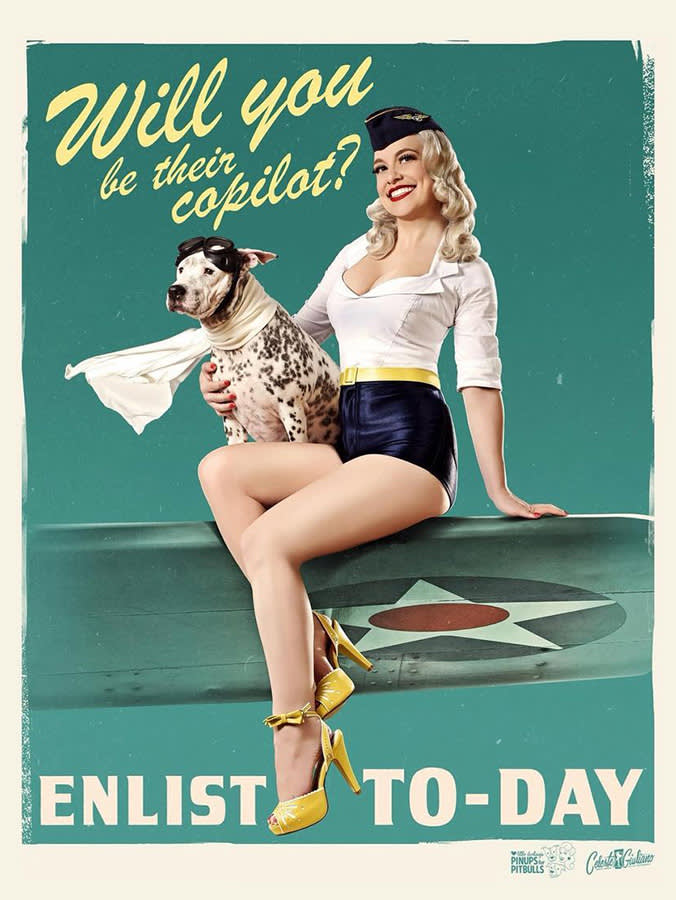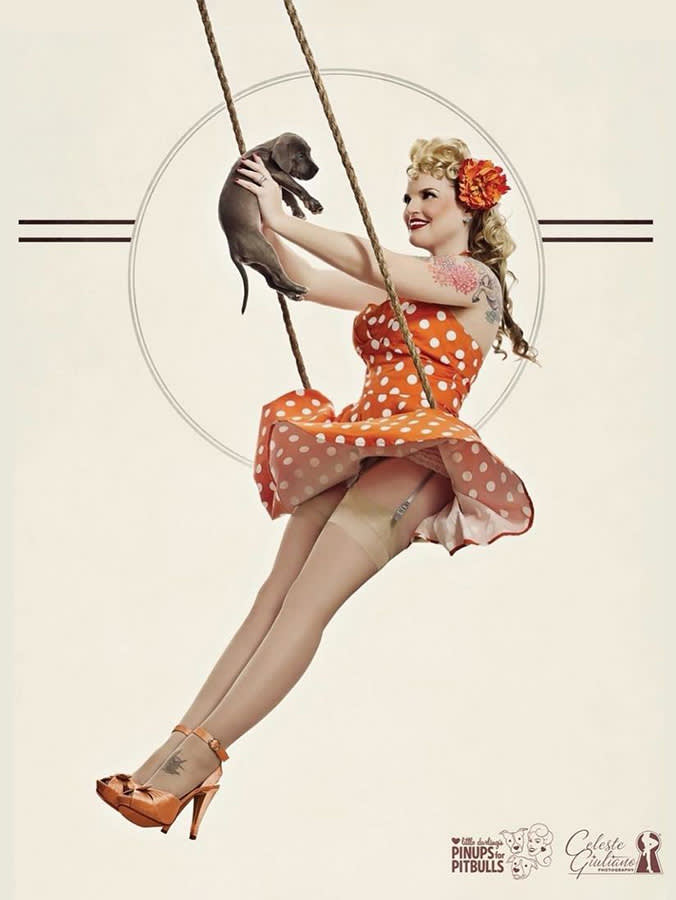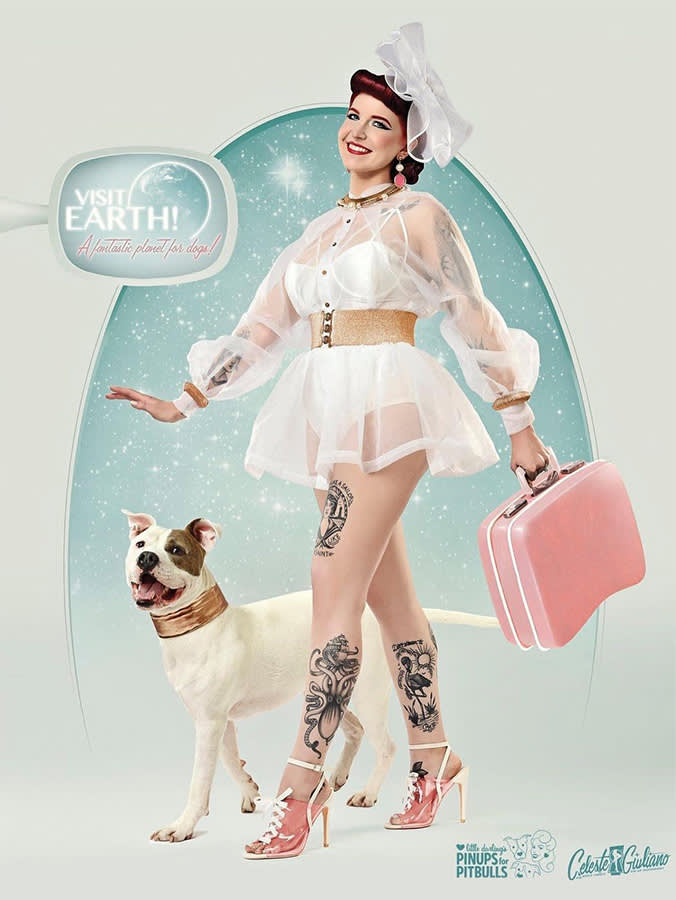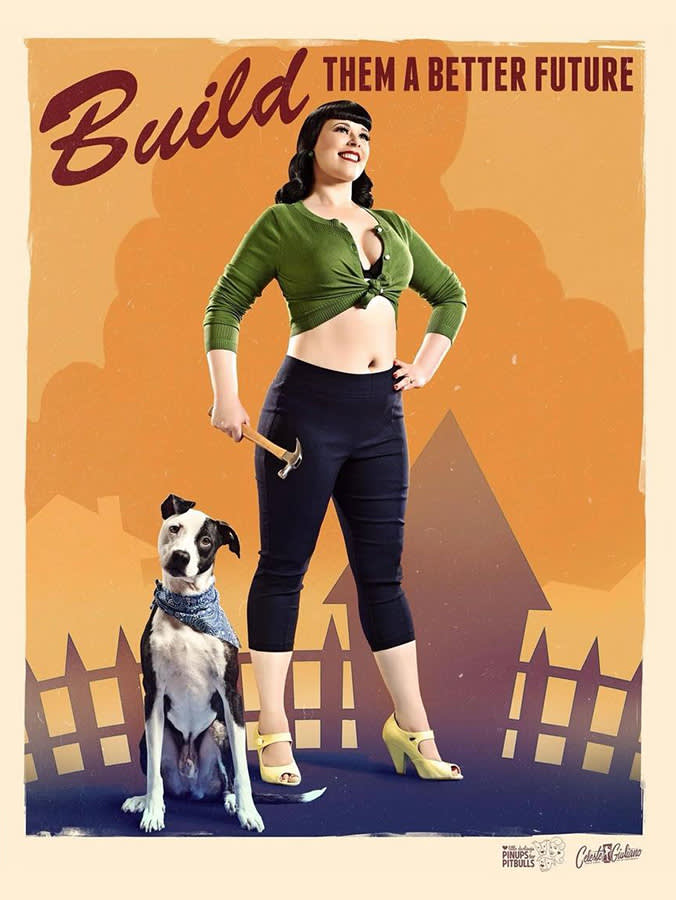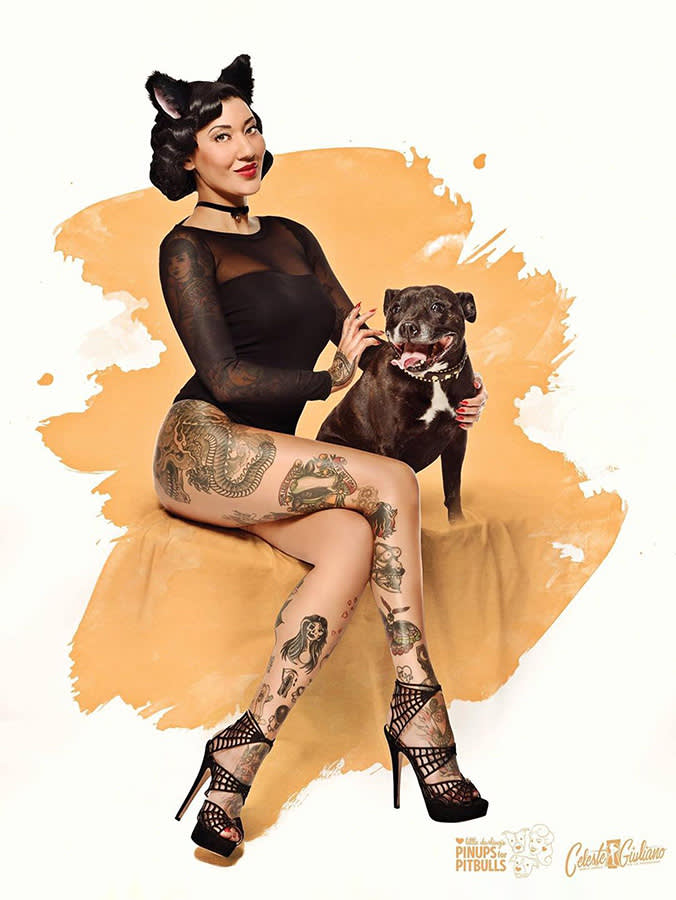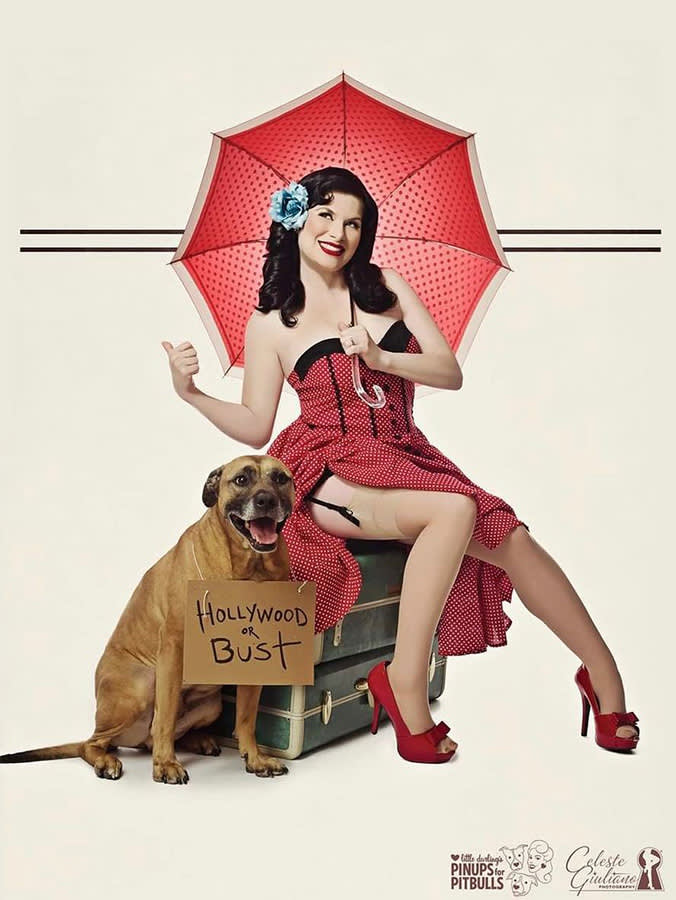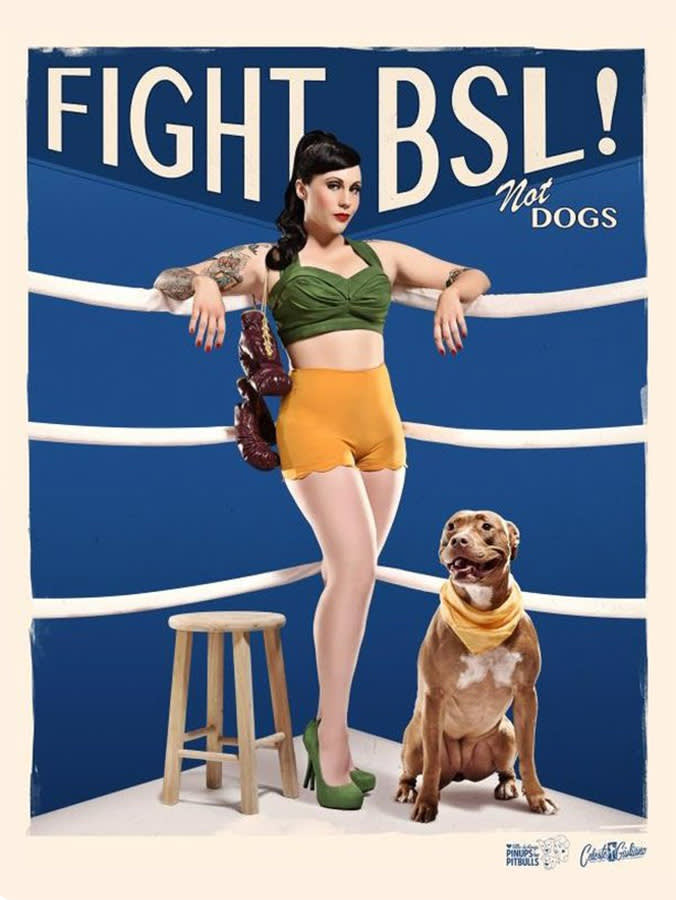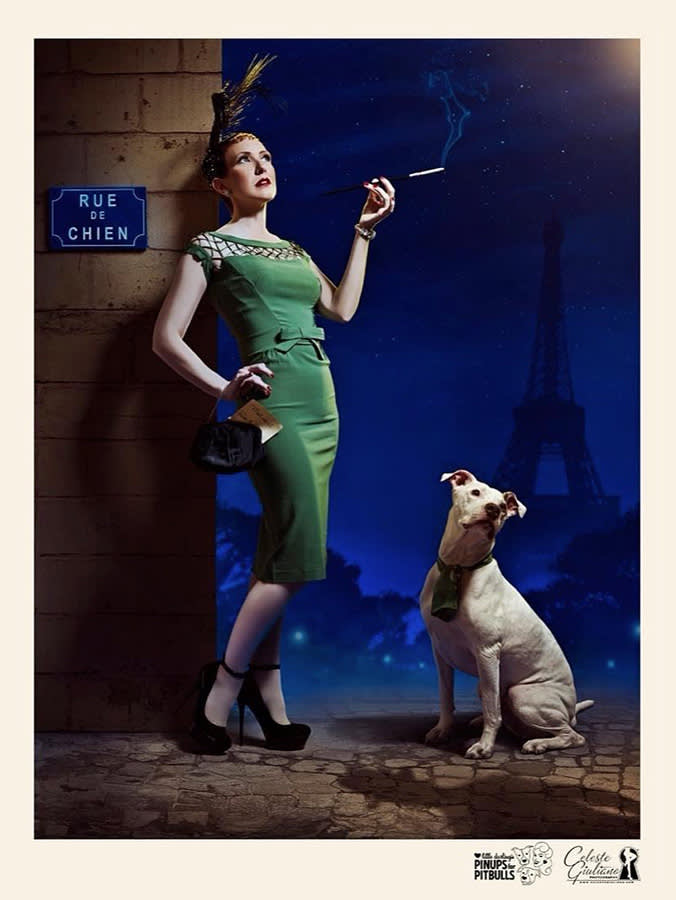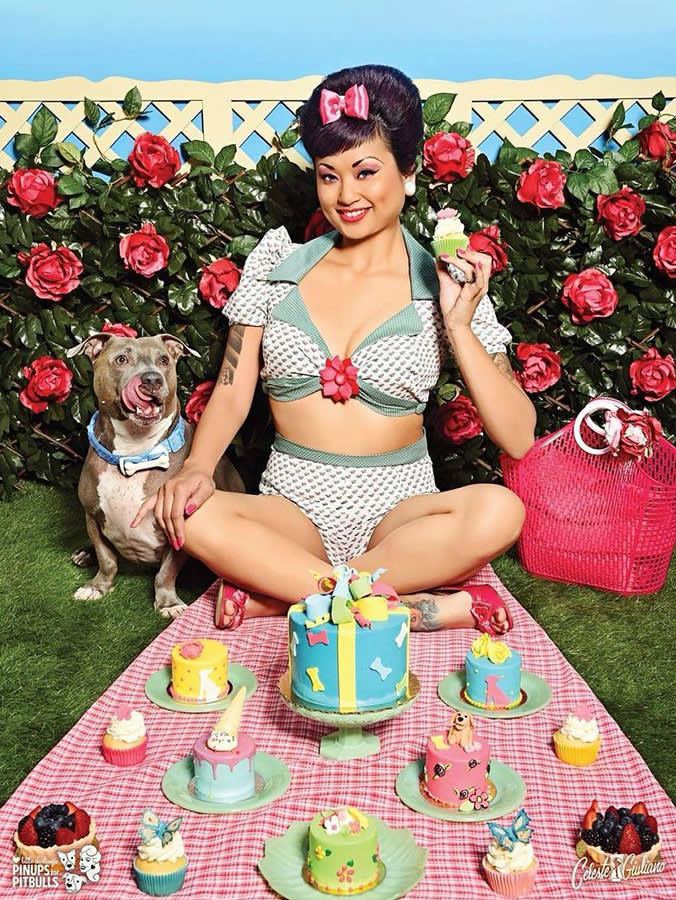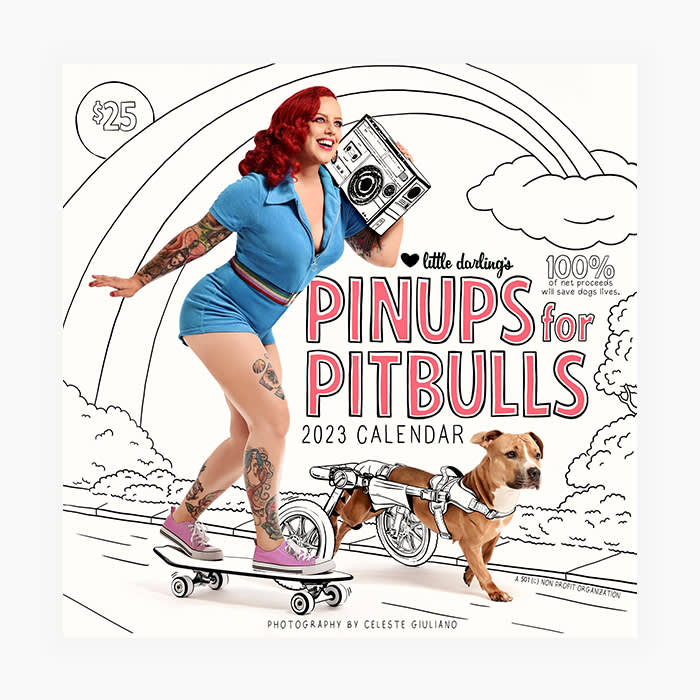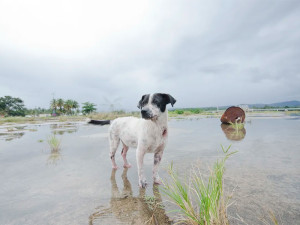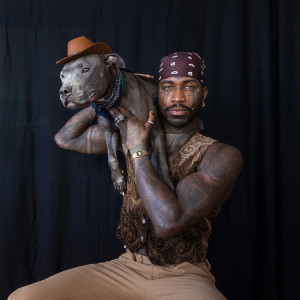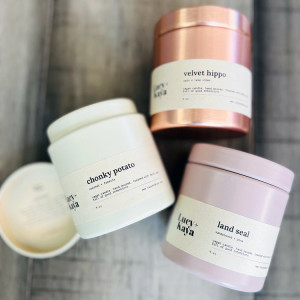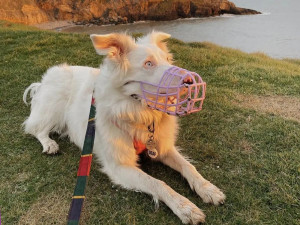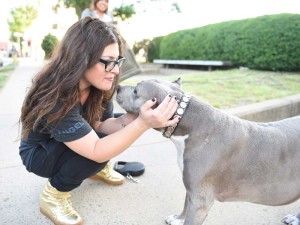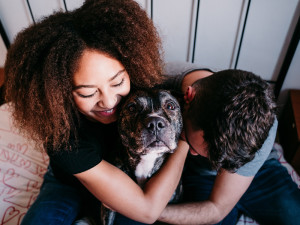Pinups for Pitbulls Rolls Up the Victory Curls For the Pups Who Need It Most
Back in the day, pinup models donned their victory rolls to boost wartime spirits. Now, they do it to advocate for a much-maligned dog breed. Deirdre Franklin, the founder of Pinups for Pitbulls, explains how a burlesque hobby evolved into a life-saving non-profit.
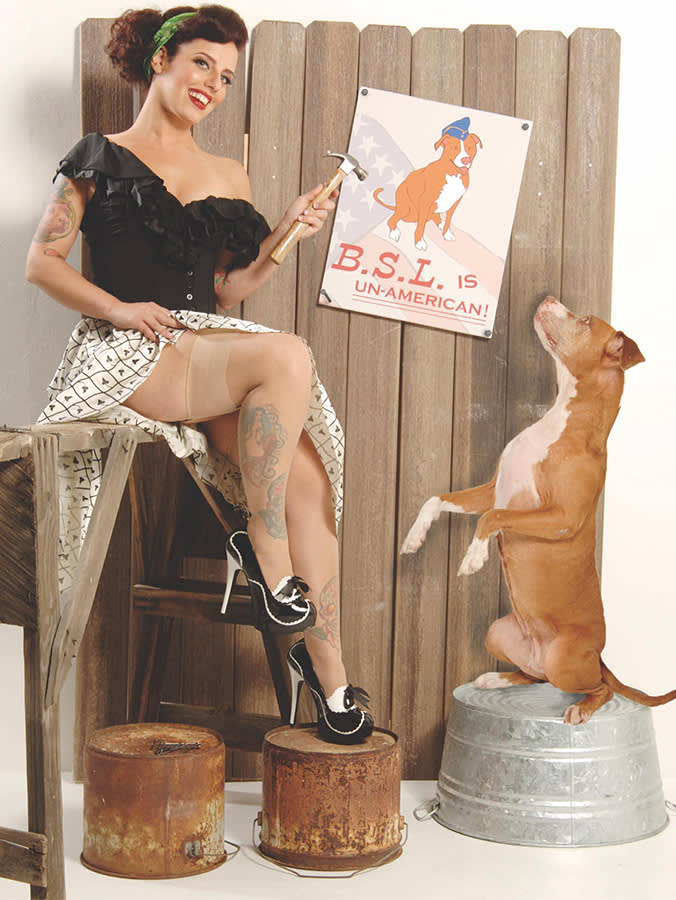
Share Article
We all know the pinup aesthetic: a glamorous, rosy-cheeked woman standing — or lounging — confidently and alluringly, giving a wide smile or sly pout to the camera. The classic pinup style popped up in the 1940s, when the “victory roll” hairstyle gained momentum; artwork of pinups would decorate World War II barracks, ships, submarines, and fighter planes. Burlesque, a fashion and dance style that has been around in varying forms since the 1840s, similarly took on new shapes in the mid-1900s. Today, pinup and burlesque are often celebrated for their body-positivity and self-confidence messages.
Deirdre Franklin, a lifelong dog-lover, found herself part of the burlesque community in the “MySpace era,” and she rapidly gained a fan base for her creative costumes. When she funded her animal advocacy efforts using donations from her burlesque fans, she realized she could combine her love of animals and dress-up into one productive, thrilling project: Pinups for Pitbullsopens in new tab, an organization that is known for making pinup-style calendars that raises money and awareness for Pit Bull protections. Today, Pinups for Pitbulls is made up of a team of volunteers in over 20 states and saves 1,000 dogs annually. They have overturned breed bans, adopted out Pit Bulls, and changed countless peoples’ biases about Pit Bulls.
This year’s calendar is their last — but don’t worry: They��’re not going anywhere. Instead, they’re starting a new chapter focused on education, activism, and reduced waste. As always, 100 percent of the net proceeds of the Pinups for Pitbulls 2023 calendaropens in new tab will go to saving dogs’ lives through adoption and community outreach. Below, Kinship spoke to Franklin about her journey falling in love with Pit Bulls and the always-evolving future of Pinups for Pitbulls.
Have you always been an animal lover?
I was definitely an animal lover from a very young age. I remember I was in ballet and tap and all those things when I was a little kid; we’d perform to that song “If I Could Talk To The Animals” from Dr. Doolittle. And it really spoke to me, even as a five-year-old. I just identified with animals, loved them, and didn’t understand why the world was created in such a way that animals were not as valued as other lives.

What made you start loving Pit Bulls?
[When I was about 17] I started volunteering at a shelter in Philadelphia...They had a kill policy for Pit Bull-type dogs — meaning if they identified a dog that looked like a Pit Bull- type dog, they would automatically euthanize it, no questions asked. And I agreed to that when I first volunteered, ’cause I didn’t really understand and was figuring the shelter must know better than I know.
It didn’t really affect me until a dog was actually brought in that was a Pit Bull-type dog. [The person at the front desk told the rescuer]: “If you leave this dog here, we’ll euthanize it. She won’t be put on the adoption floor.” The lady was told that there were other shelters in Philadelphia she could take it to that wouldn’t necessarily take that approach, but the lady didn’t have time. So, she left it there. And that was the moment that I realized, “I have to be an advocate for this dog.”
That must have felt devastating. What did you do?
This was 1996 or so, so there is no Google, there was no Petfinder. I rode my bicycle home very upset and got on my computer, and the only thing I could find rescue-wise to try to help me get this dog out of there was a rescue in Texas called Chakoopens in new tab. I wrote them an urgent email and basically begged them to help me see if I could foster through them or have them pull the dog. They ended up reaching out to the shelter right away — totally stepping in like a hero and wanting to help me help this dog.
The [Philadelphia] shelter still stood by their word and said, “This is our policy. We’re not going to let this dog leave, and that’s it.” Obviously, I was devastated. Chako had reached out to me and apologized [that they couldn’t help the dog in Philadelphia]...they wanted to know if I was interested in adopting another female Pit Bull who they had just rescued from a house that was abandoned in College Station, Texas.
And you said yes, just like that?
I was just shooting from the hip, like, OK, this seems like what the universe wants me to do. Again, not going from the logical place at all, just speaking totally from the heart. I was like, yes, I’ll apply for this dog. She was shipped to me to Newark, New Jersey and brought out to me from a forklift in her airline crate, like she was a wild beast. And I was just like, What did I get myself into? They opened the airline kennel, and thankfully she jumped out to me immediately and became Carla Lou, who was the dog that inspired it all.
How did you come up with the idea for Pinups for Pitbulls?
The inspiration for Pinups was: How do I get people to pay attention to something that I want them to pay attention to on a subject that most people really don’t care that much about — unless it affects them personally? That’s why I made a calendar to trick people into paying attention.
How did Pinups get off the ground?
This was the MySpace era. I was a burlesque performer at the time — I was doing a lot of alternative modeling — just for fun, really. I just liked to play dress-up and play characters. I had a lot of fan base and attention from that. And it always felt empty and strange to me to just put things out but not really have any purpose to it.
Then Hurricane Katrina happened, and I was able to volunteer to go to Lamar Dixonopens in new tab in Baton Rouge and help with that, and that was solely funded through the people that followed me on MySpace. I basically said, “I want to go, and I want to help, but I have no way of paying for this.” I had strangers sending me money on PayPal to buy a plane ticket and to go help through HSUSopens in new tab. I was able to raise almost $2,000 for my ticket and for medical stuff and anything else that was needed. And I was like, Hmm, this is interesting. I have strangers trusting me. They don’t even know me. And that was really where I was like, There’s something to this.
Did you expect it to take off the way it did?
The intent was to make a calendar. I was going to just do it at Kinko’s, and it was just going to be people who I knew in rescue and in sheltering and the dogs that were in the rescue that I volunteered with.
I was raising money at the time for the rescue I was volunteering with, Pet Rescue of Merceropens in new tab. But then it was about two years in still making calendars when the whole Michael Vick thing broke. And, all of a sudden, I was getting nonstop requests from the Associated Press and all these media outlets that want me to answer questions on Pit Bull-type dogs and dog advocacy and Pit Bull advocacy and all those things. So, I had to hurry up and get educated and represent them well.
You mentioned that you cast people you knew in rescue for the first calendar. How were the rest cast?
We put an application out, and the application asks questions, not just specific to, like, “Do you want to be a model?” Our goal is to really have people be advocates. That’s the tricky part. We have a panel of judges that reviews the applications, and the applications ask more specific things like, “What are you going to do to help Pinups for Pitbulls for their cause? How do you plan to do that?”
We also ask for their social media so we can [ask]: “Are they positive people online?” Those are the kinds of things that we’re evaluating to make sure that they’re going to be good representatives.
What’s the photography process like?
The shoots themselves take place in Philadelphia at Celeste Giuliano Photographopens in new tab y. [Celeste] is a professional pinup photographer. That’s what she does for a living. She has wardrobe, she has hair and makeup artists, she has everything there. So it’s kind of a dream experience to win a spot in the calendar in that regard.
It’s a $50 donation to get in. At the end of the day, it still helps the organization make a better part of $15,000 or more. We’re not grant-funded, so that really can carry us for half a year sometimes.
I’m sure this all changed with COVID, but you used to do a lot of in-person outreach. What was that like?
So, probably 2008 to 2015, I was speaking at a lot of pet expos, and it gave me an opportunity to educate people about breed-specific legislation. I also had gotten my master’s degree and wrote my thesis on breed-specific legislation. The pet expo that we used to do a lot of events with had expos in a lot of cities that had breed bans. It kind of worked out beautifully for us to have access to people who we could start training to be volunteers in that region.
I would say now our focus is to really try to do more things online, try to invest more through online avenues, like being podcasts guests, doing interviews, things like that. It’s really time to hunker down and focus on the education piece.
Is the calendar something you’re still planning to continue?
We have a 2023 calendaropens in new tab, but that’ll be our last calendar. Our whole primary goal is to educate people. If the calendar is no longer educating people the way it used to or inspiring people to get involved the way that it used to, then it’s time for us to come up with something else to do in terms of ways to educate. We’re looking more at social-type things, like Patreon, and making more creative videos to make things fun and educational so that they’ll get shared.
What would you like your call to action to be? How can people help besides donating?
In terms of call to action and breed bans or fighting breed-specific legislation, I highly recommend people download my thesisopens in new tab. It’s free, and it’s a pretty easy read, considering that it’s science-heavy, but it’s got everything that they need. Or if they want a simpler version, my book, The Pit Bull Lifeopens in new tab, that was coauthored with Linda Lombardi from The Associated Press.
What drives you and keeps you motivated?
I think self-care is — as much as it’s been repeated a thousand times lately through every channel — especially important. A coworker challenged me to do a daily meditation. We both downloaded the Calm app, and I take 10 minutes now to do a meditation every day, and we keep each other in check. I think, before I did that, I was really, really, really close to burnout — like edges away from just fully not wanting to do this anymore. I’d been seeing too many hard things for too long and really didn’t have anywhere to put it.
We really built a family of people who care about each other [at Pinups for Pit Bulls]. We’ve gotten through divorces together and child loss and children being born, and all kinds of pretty intense life things that have happened simultaneously. Being able to support each other in that way and hold onto our humanity, I think, is really what keeps it all together.

Sio Hornbuckle
Sio Hornbuckle is the Assistant Editor at Kinship, where they frequently write for the site. As a writer, they specialize in pet news, animal science, and pop culture. They live in New York City with their cat, Toni Collette.
Related articles
![Sophie Gamand photograph of dead dog beach in puerto rico]()
How Sophie Gamand Showcases the Gentle Souls of Misunderstood Dogs
The artist and activist on how her work has helped hundreds of dogs get adopted (and how she copes with the heartache of photographing shelter and street dogs around the world).
![Yves, a man with a lot of tattoos and a brown paisley head bandana in tan pants holding his grey Pitbull dog who is wearing a tiny cowboy hat over his shoulder]()
The Misunderstood Pit Bull Is at the Top of Yves’s Advocacy List
The model, activist, and musician on his activism philosophy: “I’ve always been drawn to those who have been left behind, forgotten, misunderstood. I relate to them on a very deep, personal level. No matter how different you are, everyone deserves a chance.”
![three lucy and kaya candles (white candle named chonky potato, pink named land seal, and rose gold named velvet hippo) all for the stand up for pit bulls fundraiser]()
This Candle Brand Is Keeping it Lit for Pit Bulls
Each month, Lucy and Kaya donates a portion of proceeds to a different dog rescue. For October, it’s Stand Up for Pits.
![White Shepherd mix dog wearing a pink muzzle while sitting on the grass with sunset cliffs and the ocean in the background]()
Muzzle Up Project Wants You to Remove Your Judgment Goggles When You See a Muzzled Dog
How the misunderstood training tool actually empowers dogs to be “happy, fulfilled, and living their best lives.”
![Rebecca Corry with her dog]()
Comedian Rebecca Corry Stands Up for Pit Bulls
“Comedy and entertainment — that’s my passion. But my purpose in life is saving dogs. And somehow I have managed to combine the two.”
![Couple hugging their Pit Bull]()
What Is a Pit Bull, Exactly?
Everything you need to know about the five breeds dubbed “Pit Bulls.”
